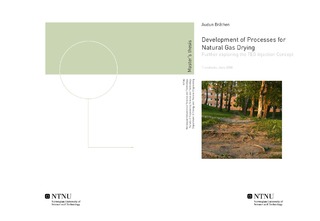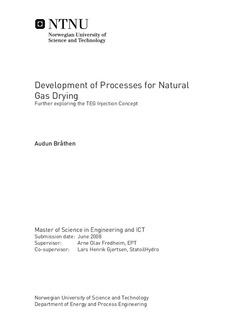| dc.contributor.advisor | Fredheim, Arne Olav | nb_NO |
| dc.contributor.advisor | Gjertsen, Lars Henrik | nb_NO |
| dc.contributor.author | Bråthen, Audun | nb_NO |
| dc.date.accessioned | 2014-12-19T11:44:30Z | |
| dc.date.available | 2014-12-19T11:44:30Z | |
| dc.date.created | 2010-09-04 | nb_NO |
| dc.date.issued | 2008 | nb_NO |
| dc.identifier | 348627 | nb_NO |
| dc.identifier | ntnudaim:4207 | nb_NO |
| dc.identifier.uri | http://hdl.handle.net/11250/233647 | |
| dc.description.abstract | This paper treats further development of the TEG injection process described in Bråthen (2007). An introduction to separation technology, conventional glycol regeneration and compact mixing is presented, as these are important parts of the alternative dehydration concept. Advantages, disadvantages and operational problems are pointed out, before the problems with the TEG injection process is described. Using hot stripping gas for regeneration of the TEG is one of the suggested improvements, but large glycol losses, large flow rates of stripping gas and oxidizing of glycol are found to be the consequences, thus making the alternative unfeasible. The only improvements used, are to use inline separators for the first separation stages and compact mixers for mixing of TEG and natural gas. A simulation model is developed using the simulation software HYSYS with the CPA EoS as fluid package. Both the absorption and the regeneration part of the process is modeled, and operational data from the Snøhvit LNG facility is used as reference. From simulations it is found that TEG injection requires about 50% more circulated TEG than conventional absorber dehydration to obtain the same water content in the dehydrated gas. The weight and volume of the absorption part of the process is however found to be considerably smaller than the operational process at the Kristin field in the Norwegian North Sea, thus partly compensating for the increased TEG circulation rate. Use of MEG and DEG instead of TEG for the injection concept is also simulated, but it is concluded that TEG is the best suited because of lower regeneration energy, lower absorbent loss and best dehydration performance for low to intermediate flow rates of stripping gas. MEG is found to be unsuited for dehydration because of very large losses of absorbent. | nb_NO |
| dc.language | eng | nb_NO |
| dc.publisher | Institutt for energi- og prosessteknikk | nb_NO |
| dc.subject | ntnudaim | no_NO |
| dc.subject | MTING ingeniørvitenskap og IKT | no_NO |
| dc.subject | Energi- og prosessteknikk | no_NO |
| dc.title | Development of Processes for Natural Gas Drying: Further exploring the TEG Injection Concept | nb_NO |
| dc.type | Master thesis | nb_NO |
| dc.source.pagenumber | 124 | nb_NO |
| dc.contributor.department | Norges teknisk-naturvitenskapelige universitet, Fakultet for ingeniørvitenskap og teknologi, Institutt for energi- og prosessteknikk | nb_NO |

